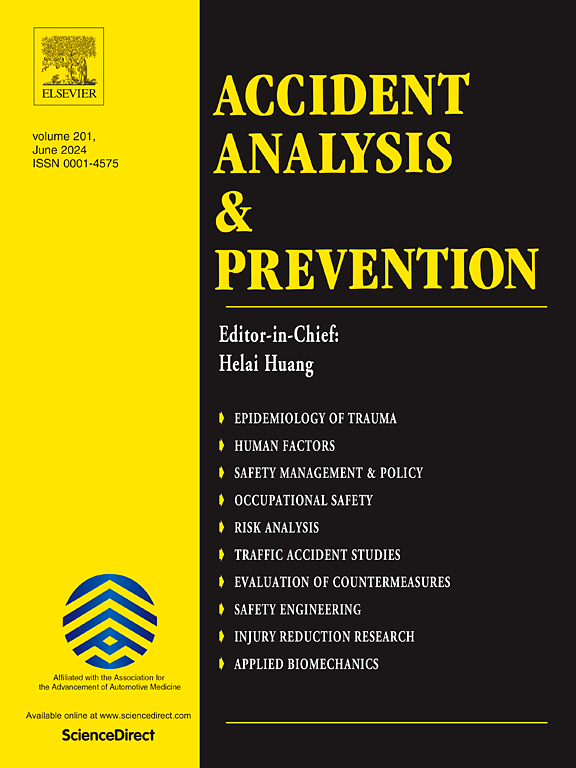Spatio-temporal crash severity analysis with cost-sensitive multi-graphs attention network
IF 5.7
1区 工程技术
Q1 ERGONOMICS
引用次数: 0
Abstract
Most conventional crash severity models attempt to achieve a low classification error rate, implicitly assuming the same losses for all classification errors. In this paper, we suggest that this setting has limitations in terms of reasonableness, as accurately identifying the significant contributing factors to more severe crashes is more important than identifying those for less severe crashes in crash severity analysis. In addition, the spatio-temporal heterogeneity in existing crash severity models is usually explored utilising statistical models or pre-learned by shallow machine learning models. To the authors’ best knowledge, the advanced deep neural networks have received less attention in the context of learning spatio-temporal crash severity structure. To tackle these two issues, this paper firstly reformulates the crash severity analysis as a cost-sensitive learning problem, where a cost matrix is defined to measure the unequal misclassification losses in crash severity analysis. Furthermore, to obtain a more accurate representation of spatio-temporal heterogeneity for crash severity analysis, we develop the multi-graphs attention mechanism, which takes the advanced graph convolutional network as the base learner. As a result, a cost-sensitive multi-graphs attention network (CSmGAT) model is finally proposed, which, on the one hand, learns the optimal spatio-temporal affiliations from crash severity data by performing multi-graphs attention convolutions to filter out the error affiliations in pre-defined spatio-temporal graphs and, on the other hand, embeds the cost matrix and aims to perform cost-sensitive crash severity analysis by minimising the overall misclassification losses of training data. In the experimental part, a five-year vehicle–vehicle crash dataset from Victoria State, Australia is utilised for crash severity analysis. In comparison with 23 state-of-the-art crash severity models, our proposed CSmGAT model can reduce the overall misclassification losses by at least 11.31%. The most significant crash contributing factors have also been identified and interpreted based on the pseudo-elasticity values.
利用成本敏感多图注意力网络进行时空碰撞严重性分析
大多数传统的崩溃严重性模型试图实现低分类错误率,隐含地假设所有分类错误的损失相同。在本文中,我们认为这种设置在合理性方面存在局限性,因为在碰撞严重性分析中,准确识别导致更严重碰撞的重要因素比识别不严重碰撞的重要因素更重要。此外,现有碰撞严重程度模型的时空异质性通常是利用统计模型或浅层机器学习模型预学习来探索的。据作者所知,先进的深度神经网络在学习时空碰撞严重程度结构方面受到的关注较少。为了解决这两个问题,本文首先将碰撞严重性分析重新表述为代价敏感学习问题,定义代价矩阵来度量碰撞严重性分析中的不等错分类损失。此外,为了更准确地表征碰撞严重性分析的时空异质性,我们开发了以高级图卷积网络为基础学习器的多图注意机制。最后提出了一种代价敏感的多图注意网络(CSmGAT)模型,该模型一方面通过多图注意卷积从碰撞严重程度数据中学习到最优的时空关联,过滤掉预定义时空图中的错误关联;另一方面,嵌入代价矩阵,通过最小化训练数据的总体误分类损失来进行代价敏感的碰撞严重程度分析。在实验部分,来自澳大利亚维多利亚州的五年车辆碰撞数据集被用于碰撞严重性分析。与23个最先进的碰撞严重性模型相比,我们提出的CSmGAT模型可以将总体误分类损失减少至少11.31%。在伪弹性值的基础上,确定并解释了最重要的碰撞因素。
本文章由计算机程序翻译,如有差异,请以英文原文为准。
求助全文
约1分钟内获得全文
求助全文
来源期刊

Accident; analysis and prevention
Multiple-
CiteScore
11.90
自引率
16.90%
发文量
264
审稿时长
48 days
期刊介绍:
Accident Analysis & Prevention provides wide coverage of the general areas relating to accidental injury and damage, including the pre-injury and immediate post-injury phases. Published papers deal with medical, legal, economic, educational, behavioral, theoretical or empirical aspects of transportation accidents, as well as with accidents at other sites. Selected topics within the scope of the Journal may include: studies of human, environmental and vehicular factors influencing the occurrence, type and severity of accidents and injury; the design, implementation and evaluation of countermeasures; biomechanics of impact and human tolerance limits to injury; modelling and statistical analysis of accident data; policy, planning and decision-making in safety.
 求助内容:
求助内容: 应助结果提醒方式:
应助结果提醒方式:


